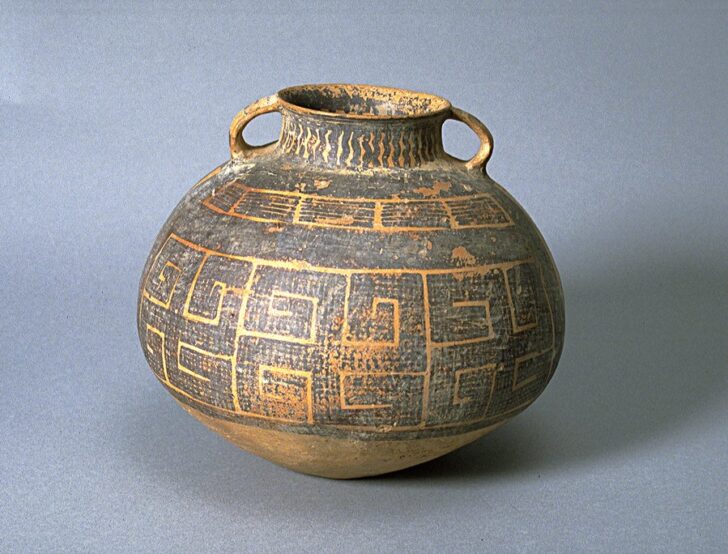Jar
Chinese

Description
Subject Matter:
A mortuary urn or guan 罐 jar of the Neolithic Machang phase (2300–2000 BCE) of Majiayao Culture from Machang, Gansu of the Yellow River Valley in northwestern China. Discovered by Johan Gunnar Andersson in 1921, by the 1980s approximately 60,000 items and 400 kilns had been discovered at Majiayao sites (He Li 1996, 22). They were found in subterranean graves with conical bases placed into the local loess soil, and because the decoration is consistently only on the top portion of the jar, it can be assumed they were meant to be viewed from above. While it is impossible to know the meaning behind this decoration, perhaps it has religious or ceremonial importance, it is possible that the network of coils represents swirling eddies of water and fishing nets, from the nearby Yellow River which was a major source of food. The two lug handles were probably used to tie down a wooden, or other decomposable material, lid.
This type of guan is extraordinarily thin and lightweight. Constructed by using the coiling method, they were then paddled and scraped thin, covered in a fine slip, and then painted with mineral pigments before being fired in small, simple updraft kilns. The mineral pigments consisted of iron and manganese oxides to give red, brown and black hues.
Reference:
He, Li. Chinese Ceramics: a New Comprehensive Survey From the Asian Art Museum of San Francisco. New York: Rizzoli, 1996.
Physical Description:
A light reddish-buff earthenware guan 罐 jar with a wide globular upper body and conical lower body on a flat base, and a short narrow neck with an everted, direct rim. There are two diametrically opposed lug handles connecting the rim to shoulder. The upper three-fourths of the body is painted with black pigment to depict six counter-clockwise sauvasticas (swastikas), or equal armed crosses, with each arm continued at a right angle into a squared coil. Each sauvastica is made up of a network of fine lines, with a shoulder band made up of five on one side and six on the other. Groupings of six or seven stacked horizontal lines, vertical wavy lines, and zigzags are around the interior and exterior of the neck. All patterns are separated and confined between solid band borders.
Usage Rights:
If you are interested in using an image for a publication, please visit https://umma.umich.edu/request-image/ for more information and to fill out the online Image Rights and Reproductions Request Form.